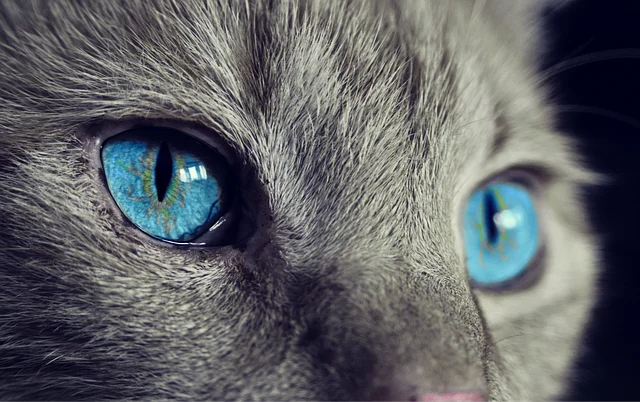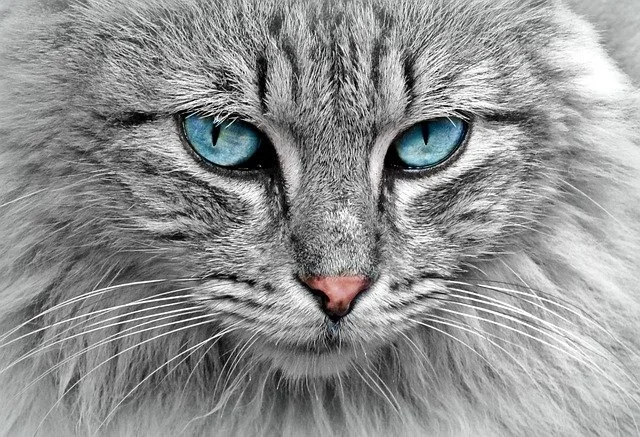What colors do cats see best

The glowing eyes of cats in the dark seem mystical and even frightening, especially if you suddenly see a dark cat in the night. For thousands of years, cats have been a source of fascination and mystery to humans. And only in our time, with the help of new tests and technologies, a person could give answers to feline riddles. Some of the most interesting questions related to cat anatomy were: “What colors do cats see best” and “Why do cats see so well in the dark”.
Of course, a cat’s eye structure is ideally suited to vision at night. To begin with, you have certainly noticed that the cat’s eyes are very large concerning other parts of the body. This is no accident because the cat is a night hunter. If you look at nocturnal and crepuscular animals, then all of these species will have large eyes, such as an owl or a bat. The larger the eyes and pupils, the better the animal picks up the slightest light.
There is a simple explanation as to why cats’ eyes have a green or gold sheen. The whole answer is in the structure of the pupil, a membrane called “Tapetum Lucidum” gives the glow to the eye. This amazing gimmick of a cat, which is absent in human eyes, helps to enhance any glow. When the cat is in the dark, its pupils are wide open, and light is reflected from their eyes, betraying a luminous glow. This ability, along with their extraordinary sensitivity to ultraviolet rays, gives cats the ability to see perfectly in the dark.
Many people don’t know what colors cats see. Someone thinks that they are color blind and see the world only in gray. This is a false statement. Scientists have proven that cats can distinguish certain colors.
Mostly cats see the world around them in shades of blue and green. A person distinguishes between the main three colors, cats are similar, but they see some colors much worse. Any cat can be compared to a color-blind person.
Cats have only two cones in the eye, which are sensitive to blue and green colors; therefore, they are not able to distinguish shades of red. Reds are rendered as grays to the cat. The fact that cats do not distinguish between all colors does not hinder them in any way and does not in any way affect their survival. In any case, the eyes of a cat have not been fully studied, and it may happen that after a few years, scientists will say that cats can see all colors perfectly.
Can cats see in the dark?

Cats, like humans, do not have the ability to see in complete darkness, but unlike humans, they see very well in the twilight. Cats pick up any light seven times better than any human. Their pupils are narrow during the day and wide at night, perfect for night hunting. Cats see especially well when they are in motion. By the way, never feed your cat with dog food, as it does not contain the right amount of taurine, which is so important for cats’ eyesight; otherwise, your cat could go completely blind.
Previously, trying to determine what colors cats see, scientists worldwide were convinced that this is a black and white spectrum and all shades of gray. To date, it has been proven that these animals still have color vision. It differs greatly from the human one in terms of the range of shades, brightness, and contrast.
Eye structure
Why is this happening? The cat has a different eye structure. Outwardly, you can see that the animal’s eyes are very large, convex, with a huge pupil. It can shrink or expand depending on the intensity of the light. Every eye has many special cells called photoreceptors.
They are divided into two types. The rods are responsible for twilight vision, and the cones are responsible for their sharpness. Thanks to this, the cat can distinguish between small objects and different colors. Each animal’s eye covers 45 percent of the visible image.
Since a cat is a nocturnal hunter, its vision is more adapted to conditions with a minimum of light. Perhaps this explains the imperfection of color vision. In dim light or semi-darkness, the cat sees only gray shades but of different tones.
The cat has an interesting retina covered with a tapetum at the back. The substance works like a mirror – it reflects the light that hits it. As a result, the cat’s eyes begin to glow. It can be different – green or red. In the first case, such a glow is observed in animals with yellow eyes, in the second – with blue ones. At the same time, the spectrum of colors they see is preserved in the same way.
How many colors are there in the cat range?

Since a cat is a born hunter, scientists have previously assumed that she sees only gray shades. This is how rodents are colored, which are the main prey. However, to date, there have been many studies that prove that there is a certain color scheme that a cat sees, distinguishes colors:
- black;
- White;
- gray and all its shades;
- yellow;
- green;
- blue.
Cellular cone-shaped receptors located in the eye’s retina are responsible for the color vision of the surrounding world. Since the brightness of the images is greatly reduced, the cat can often confuse white with yellow, and almost black with orange or red.
At the same time, it is not difficult for an animal to determine the color from 700 meters if the object of attention moves along a horizontal surface. When an object slides vertically and slowly, the animal not only does not consider the color but may not see it at all if it is near or further than six meters.
It is believed that a gray color in a cat can be freely divided into 24 shades. Best of all, the animal perceives “cold” shades. After many studies to determine the color scheme in cats, it was found that animals do not perceive some of the shades at all.
For example, a cat sees red objects as gray, light green. Yellow can be mistaken for white. Lighting plays a big role in such errors. When good, the cat can even distinguish purple.
What colors and shades are available for the feline?

They have a peculiar eye structure. It allows you to examine a mouse running a few meters away in detail and completely blurs a distant or too close image. Animals see the world mostly in black and white.
A cat also has color vision, like a dog. However, she sees the image in pastel colors. The cat does not distinguish some colors at all (for example, red). Most animals see yellow-gray tones with greenish-blue blotches.
Colors inaccessible to cats
Despite the fact that cats can distinguish colors, there is one peculiarity – some of the shades remain inaccessible to them. The question arises “what”? These include:
- Red;
- Brown;
- Orange;
- Multi-colored combination.
Although the cat can distinguish green color, it is very weak. They find the grass they need, which animals often chew, mainly by smell. The cat can perceive red as green, and purple can be mistaken for blue. Animals also do not perceive other variations with these colors.
Features of color perception
For a cat, the color scale, in principle, does not matter. The animal shades are not at all important and unnecessary. To compensate for the lack of brightness and contrast, they are given by nature a sense of touch and smell, far exceeding human.
In the dark, the cat does not distinguish any colors at all, except for gray, black, and white. In the daytime, the environment is perceived mainly in the yellow-blue spectrum. There is no particular difference between red, brown, and green for animals. At night, the cat is able to distinguish more than a hundred gray shades.
By focusing on what color cats see, they can create even more comfortable conditions at home. For example, pick up some accessories. According to the “autumn” range, buying bedding and toys in pastel colors is best. It is best to stop the choice of lemon yellow, terracotta, blue.
It has long been known that a cat perceives dynamic objects much better than statistical ones. For example, she will well see a sparrow jumping six meters away from her, but she may not see a sausage lying before her until she smells it.
Kittens are born blind, and only by three months of life, their vision is fully formed. Pet owners are interested in knowing what colors cats can distinguish.
Any cat with great pleasure chases the red beam of a laser pointer. However, the color of the beam does not matter much, the cat will also have fun at the sight of a sun bunny, pale yellow. The cat reacts to the movement of the beam, but it doesn’t care about the color. The hunting instinct awakens in the animal at the sight of the rapid movement that the beam creates.
Better visibility

The viewing angle of cats is greater than that of their owners. It turns out a kind of panoramic shooting instead of the usual “video”. In other words, cats’ peripheral vision is better developed than ours.
This “wide-angle lens” allows these small predators to spot the movement of prey out of the corner of their eye. And then it’s a matter of technology: a dexterous and jumping cat usually has a successful hunt.
Less range
In the distance, cats see much worse than humans with normal vision. An eye like an eagle – definitely not about them.
Purrs do not need this because they do not hunt in open spaces. Their lot is numerous cover and ambush attacks. There are no such distances in a forest or in a country house that will become a problem for the cat’s eyes. Up close, the fuzzies can see clearly enough to successfully catch the intended prey in the thickets of grass. Or among furniture, if the prey is a favorite toy.
25 facts you didn’t know about cats
• The imprint of the cat’s nose surface is unique.
• Kittens are blind and deaf at birth.
• In a kitten, eye color may change with age.
• For a cat to see, 1/6 of the light necessary for a person is enough.
• Sometimes cats have color blindness. A color-blind cat sees green as red and red as green.
• White cats with blue eyes are most often deaf.
• Cats can see up to 60 meters.
• Cats can distinguish colors.
• Many cat breeds do not have eyelashes.
• In terms of body size, a cat’s eyes are much larger than those of other animals.
• Cats hear much better than humans.
• A cat has 32 muscles in each ear (a person has six). The cat’s ear can be rotated 180 degrees.
• There are 517 muscles in the body of a cat, and 650 in humans.
• An adult cat has 30 teeth.
• 10% of a cat’s bones are in the tail.
• The spine of a cat is 30 vertebrae, the spine of a human – 25.
• The skeleton of a cat contains 230 bones, and a human – 206.
• Calico and tortoiseshell colors are found only in cats.
• The body temperature of a cat is 38 degrees, this is not the weather in Zaporizhzhia, where everything is constantly changing.
• When licking fur and urinating, the cat spends an equal amount of liquid.
• Cats make 20-40 breaths every minute.
• A cat’s heart beats 140 times per minute.
• In humans and cats, the same brain regions are responsible for emotions.
• Cats have almond-shaped, round, and slanting eyes.
• Cats are poor at seeing fine details.




